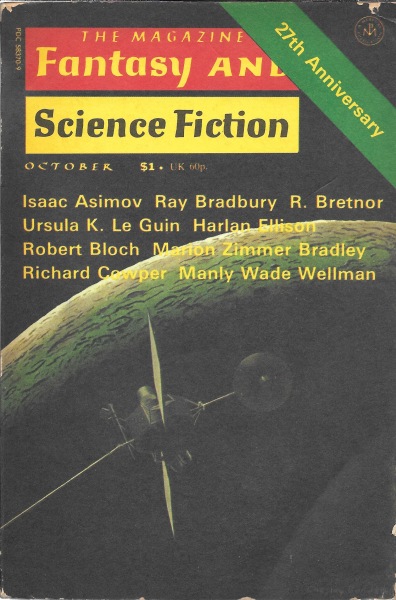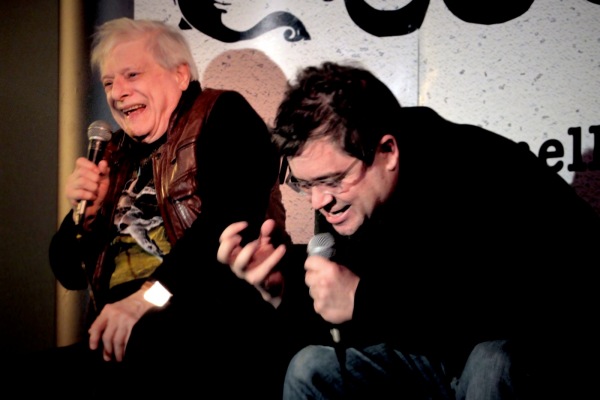
This is the fifth entry in a now most-certainly-longer-than-two-week series focusing on a horror anthology edited by Patton Oswalt called Ghost Box II (buy it here). The blog will resume its standard format in May.
* * *
During the writing of Danse Macabre, his 1981 survey of the horror genre, Stephen King invited Harlan Ellison to describe himself and his work. Ellison obliged:
“My work is foursquare for chaos. I spend my life personally, and my work professionally, keeping the soup boiling. Gadfly is what they call you when you are no longer dangerous; I much prefer troublemaker, malcontent, desperado. I see myself as a combination of Zorro and Jiminy Cricket. My stories go out from here and raise hell. From time to time some denigrater or critic with umbrage will say of my work, ‘He only wrote that to shock.’ I smile and nod. Precisely.”
It’s an honest description. Ellison was known for his volatile personality; Ghost Box II editor Patton Oswalt described him as “a man-shaped explosion.” This quality carried over into his writing, which always shone with furious intelligence and refused to be pigeonholed. Perhaps no other single story shows the scope of his range like “From A to Z, in the Chocolate Alphabet.”
“From A to Z…” was written over three days in the window of the Los Angeles bookshop A Change of Hobbit for a fund-raiser. The phrase “the Chocolate Alphabet” has no literal meaning; it was simply a title that Ellison had come up with some time prior to be used for a future story. It was first published in The Magazine of Fantasy & Science Fiction in October 1976, and later included in Ellison’s 1978 short story collection Strange Wine.

To call “From A to Z…” a story does it a disservice, because it is actually twenty-six stories, one for each letter of the alphabet, ranging from just a few sentences to two or three pages in length. When I first read it, I interpreted it as a riff on Edward Gorey’s classic 1963 children’s book, The Gashlycrumb Tinies. However, doing research, I found it was actually intended as a pastiche of the work of Fredric Brown, who was known for his mastery of the “short short” form.
And what a batch of stories! There is more raw, delirious imagination in “From A to Z…” than you will find in the entirety of some novels, and as always the quality of Ellison’s prose is unimpeachable. The tales herein span a variety of genres – horror, science-fiction, fantasy. One entry, “G Is For Golem,” is flat-out comedy: “Golems are goyim that always wanted to be Jewish. But they never suffered enough guilt.” Many of the stories end with such punchlines; I don’t think Ellison ever got enough credit for how funny he could be.
To be honest, I’ve found it difficult to write about this piece, as the stories vary so much in content and tone, and there is no common character or narrative thread to link them. The first four stories in particular I thought were quite strong, and their brevity works to their advantage. “A Is For Atlantean” relates the lost history of Atlantis; I was awed by Ellison’s descriptions of buildings made of seaweed and chilled by the final reveal. “B Is For Breathdeath,” about a flower found “virtually everywhere but the Earth” that drives the people who look at it insane, is another effective mini-nightmare. I also quite liked “D Is For Dikh,” about a man who lives deep beneath the earth and writes “unsettling” things along the walls.

Later in the piece, the blatant horror of the earlier stories is toned down and Ellison ventures more deeply into fantasy and sci-fi. I particularly liked “S Is For Solifidian The Sorcerer.” In this tale, a man attends a political fundraiser where the entertainment is an honest-to-god magician, performing actual miracles for the delight of the astonished guests. At the end of the tale, Solifidian’s wife barges into the gathering and leads him away, and he goes without protest, after which Ellison muses, “to this day, I’m always amazed at the magic hold some men have over some women…and the magic hold some women have over some men.” It’s an unexpectedly thoughtful, and even poignant, reflection in a piece that until then has mostly been a master storyteller simply flexing his muscles (not that that’s a bad thing when it’s Harlan Ellison).
I will not recap more of my favorites here; I would simply advise you to read it. I will say that Ellison wrote a sequel of sorts, called “From A to Z, in the Sarsaparilla Alphabet,” in 1990. The story sat unpublished for years, but eventually appeared in The Magazine of Fantasy & Science Fiction in February of 2001.
I would like to take a moment to note that Ellison, who died in 2018, had a personal relationship with Mr. Oswalt. Oswalt’s introduction for Ghost Box II contains a postscript eulogizing his friend: “There’s no way I can set down, now, how I feel about his passing. I’m angry about it. I’m sad he’s gone. But I – and a lot of other creative people, I’m sure – feel like part of the secret fuel for 21st-century imaginative literature has been drained away.”

As someone who was also hit hard by Ellison’s death, I can’t help but agree. As a writer Ellison was never short of brilliant, and “From A to Z, in the Chocolate Alphabet” is a testament to his singular genius. Oswalt’s postscript ends simply: “I miss you, Harlan.” Me, too.
NEXT TIME: “Witches” by Janet Fox!